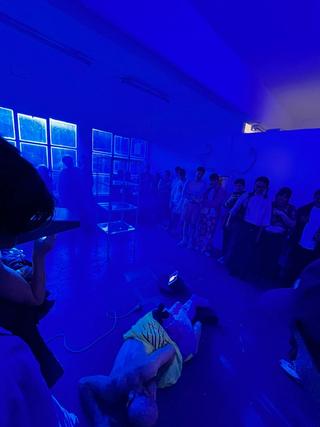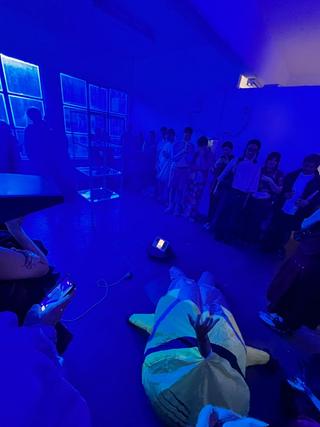

This Might Just Pass The Time
Aaron Christopher Rees, Amalia Lindo, Christina May Carey, Marcus Ian Mckenzie
8 Nov–2 Dec 2023
This project takes the film theorist’s Leo Charney’s notion of the ‘drift’ as a point of departure to build upon this notion and to work around this central question: how does the drift materialise in today’s technological disposition? Charney envisions the drift as an “ungovernable, mercurial activity,” teeming with possibilities and heterogenous in tone, drift enables one to sense the vertigo-laden uncertainty of the present. Following this philosophical mediation, drift splits along two tracks as both an ontology and an epistemology. In its ontological becoming, drift traces the relative emptiness of the everyday as "presence irrevocably becomes absence."
Drift as epistemology attempts to capture the mere feeling of time - the perception of time's flight and fragmentation - giving shape to what is essentially formless. In mutual reverberation, this project explores the drift as a pervasive atmosphere of information and our ability to process this with our own internal rhythm of interpretation. This exhibition attempts to specify this drift with greater accuracy, to give a sense of this drift happening as something tactile, as a condition, pacing, as something enfolding in everything else. In our technological disposition, this drift feels like the simultaneous dissolution of presence in wake of the overwhelming presence of everything.
Curator Annabel Brown
.
Marcus Ian Mckenzie
Opening Performance Thursday 9 Nov 6pm
Notes On The Perforganism
In which McKenzie continues his investigation into the elusive “perfoganism”: a slippery mode of performance that
may pass through a given moment as a cloud, a memory, a spillage, or stifled cough.
The perforganism reconsiders a performance event as a living organism in a process of becoming, rather than an
action taken by an individual or group.
A perforganism is a temporary umwelt: an assemblage of human and nonhuman components, material and
immaterial. Textual and textural. It may consist of vibrations, sensations, energies, ideas, durations, rumours, flows,
exotexts, phantom dramaturgies, the mind and its extensions, a misremembered voice memo.
Lodged in the swamp between performance’s supposed ephemerality and it’s sticky adherence to reproduction
through everyday physical media in the online milieu, the perforganism can perhaps be thought about in relation to
Marcel Duchamp’s concept of the “inframince”: a thinner-than-thin liminal plane between life and art capable of
producing transformation.
A perforganism’s parts do not preexist the perforganism, although they may linger beyond it as echoes, stains, faint
markings. Thus, there is no “performer” beyond the perforganism itself and its implicated constituents. The
perforganism performs as much as it is perforganised by its components, and can only be produced through
relationality. This might be a relationship between a person, an artist, a site, a sound, or another perforganism
entirely - each of which in emerge only through a type of entanglement that we might call “perforganisation”.
As such, the perforganism is maybe best understood in more magical terms: as a kind of conjuring. What esotericists
or occultists might call an “egregore”: an entity that is brought into being for a period of time via some kind of
collective unconsciousness. That which is born and dies and is reborn in an ongoing metempsychosis. A spell, a
golem, a spectre, a desire without object or origin.
























































This Might Just Pass The Time is an exhibition that reflects on the experience of being unable to locate a stable sense of the present moment.
Aaron Christopher Rees practices in the expanded field of photography; distinct ideas and working methods are linked to the processes of photography, vision and the act of seeing. Rees generates artwork through process based photographic and structuralist video techniques of making.
Recent notable exhibitions include the exhibiting as a part of “Melbourne Now,” at the National Gallery of Victoria, Firmament at NAP Contemporary, States of Disruption at the Centre for Contemporary Photography, Horizon at Caves Gallery, and not for the sake of something more at Sarah Scout Presents.
Rees has also exhibited as a part of PHOTO 2021, Spring 1883, Channels and Next Wave contemporary art festivals. In 2021 he was the recipient of the Macquarie Group Emerging Artist Prize.
Amalia Lindo (b. 1990, United States) is a multi-disciplinary artist in Naarm/Melbourne. In 2016, she completed a Bachelor of Fine Art (First Class Honours) at Monash University. Incorporating human and algorithmic decision-making into filmmaking, her work examines the effects of automated technologies, such as artificial intelligence, on human labour, behaviour and decision-making. Select exhibitions include: Melbourne Now, National Gallery of Victoria, Melbourne (2023); Represented Artists, Haydens, Melbourne (2022); Contemporary Small Sculpture Award, Deakin University Art Gallery, Melbourne (2022); The Image Looks Back, RMIT Gallery, Melbourne (2021); Computer Shoulders, Centre for Contemporary Photography, Melbourne (2019). Amalia is represented by Haydens, Melbourne.
Christina May Carey is an artist working across video, photography and installation. Currently based in Naarm/Melbourne, Carey completed a Bachelor of Fine Arts (Honours) at the Victorian College of the Arts in 2021. In 2015 she completed a Foundation in Art and Design at Central Saint Martins, London. Recent solo exhibitions include Hyacinth Gallery, Naarm/Melbourne (2022) and Kings ARI, Naarm/Melbourne (2021); and group shows at Iklectik Art Lab, London (2022), CAVES Gallery, Naarm/Melbourne (2021), Buxton Contemporary Screen Space, Naarm/Melbourne (2021) and George Paton Gallery, Naarm/Melbourne (2019). In 2021 she was selected to partake in the student mentoring program at the Ian Potter Museum of Art, and in 2020 was awarded the Majlis Travelling Scholarship.
Christina graduated from VCA in 2020 with a Bachelor of Fine Arts (Photography).
Marcus Ian Mckenzie is an experimental performance maker working in Melbourne/Naarm, originally from Tasmania/Lutruwita. His work uses the relationship between audience and performer as a site for bizarre new sensory encounters, often involving schisms in language, parafictional world-building, inter-textural soundscapes, hyperstitional mythologies and questionable dancing. Rigorously conceptless and conceptually rigourless; his work is for anybody, not everybody.
Annabel Brown is an emerging curator and writer from Naarm/Melbourne. Her practice is grounded in interdisciplinary research encompassing art history, curatorship, and philosophy. In 2020, she curated her first exhibition – If someone asks, this is where I’ll – converting a home studio into an exhibition space for a group show with Nicola Armstrong, Veronica Charmont, Olivia Davis, Lotte Frances, Charlie Kerekes and Elise Sawell. She also curated three events as part of MPavilion’s 2020 M_Curators program. In 2021, Annabel graduated with a Bachelor of Art History and Curating from Monash University. Currently, Annabel is completing a bachelor’s in fine art (Honours) under the mentorship of Tim Riley Walsh (Curator in Residence at Gertrude Contemporary) and putting together an exhibition with Amalia Lindo, Christina May Carey and Marcus Ian Mckenzie for the MADA Grad Show.




























